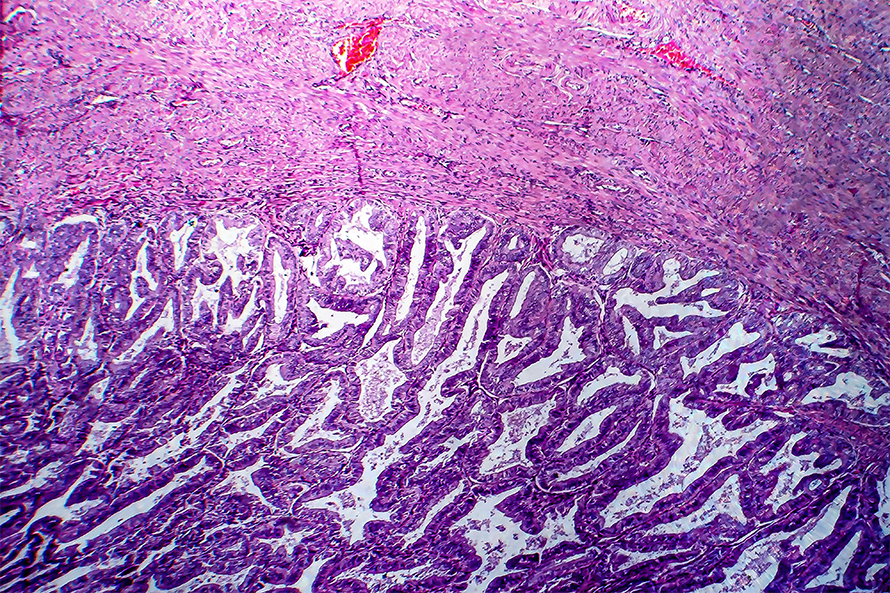Researchers find potential new target for endometrial cancers
Researchers at Fox Chase Cancer Center have discovered a potential new target in the treatment of endometrial carcinoma' The research was published recently in Molecular & Cellular Proteomics.
Using multiplexed inhibitor beads and mass spectrometry, James S. Duncan, associate professor in the cancer biology research program at Fox Chase, and colleagues profiled the kinome of endometrial tumors and normal endometrial tissues and identified a network of kinases that were overexpressed, including serine/arginine-rich splicing factor kinase 1, or SRPK1.
According to Duncan, endometrial tumors frequently have alterations in protein kinases, a family of about 535 enzymes collectively termed the kinome. Kinases are altered in about one-quarter of all cancers and are considered highly susceptible to treatment with drugs because of their catalytic activity. However, only a small fraction of the kinome has been explored therapeutically.
Multiplexed inhibitor beads and mass spectrometry is a chemical proteomic strategy that allows researchers to simultaneously look at kinase levels in cells and tumors.
"From a cancer standpoint we can identify protein kinases that are up- or downregulated in cancer," Duncan said. "Ones that are upregulated are of interest because protein kinases play a role in cancer growth, survival, and metastasis, so they often represent potential targets."
The analysis showed that SRPK1 was overexpressed in endometrial cancer tissues and that this overexpression was associated with poor survival, suggesting that SRPK1 could be involved in key tumor-associated properties, Duncan said.
"We also discovered that in combination with therapy targeting growth factors—in this case EGFR—targeting this kinase produced strong drug synergy to kill these tumors," Duncan said. This synergy was found for endometrioid cell lines and uterine serous cancer cell lines, a disease subtype with poor outcomes.
To further explore the role of SRPK1, Duncan and colleagues want to apply proteomic technology to try to understand more about how SRPK1 works and conduct experiments to see if EGFR and SRPK1 inhibition has an effect on endometrial cancer tumor models.
"This project really sums up the concept of a lot of the work that Fox Chase is trying to do when it comes to research," Duncan said. "Peggy's Pathway selected our project for funding because they thought our approach of looking at kinase signaling looked interesting, and, as a result, we have found something that may be actionable."
Peggy's Pathway for Women's Cancer Care is a charity started in honor of Peggy Pettinato, who passed away from serous endometrial carcinoma. The organization's mission is to raise funds for research into innovative treatments and early detection of endometrial cancer, the most common gynecologic malignancy in the United States.

Enjoy reading ASBMB Today?
Become a member to receive the print edition four times a year and the digital edition monthly.
Learn moreGet the latest from ASBMB Today
Enter your email address, and we’ll send you a weekly email with recent articles, interviews and more.
Latest in Science
Science highlights or most popular articles

Bacteriophage protein could make queso fresco safer
Researchers characterized the structure and function of PlyP100, a bacteriophage protein that shows promise as a food-safe antimicrobial for preventing Listeria monocytogenes growth in fresh cheeses.

Building the blueprint to block HIV
Wesley Sundquist will present his work on the HIV capsid and revolutionary drug, Lenacapavir, at the ASBMB Annual Meeting, March 7–10, in Maryland.

Gut microbes hijack cancer pathway in high-fat diets
Researchers at the Feinstein Institutes for Medical Research found that a high-fat diet increases ammonia-producing bacteria in the gut microbiome of mice, which in turn disrupts TGF-β signaling and promotes colorectal cancer.

Mapping fentanyl’s cellular footprint
Using a new imaging method, researchers at State University of New York at Buffalo traced fentanyl’s effects inside brain immune cells, revealing how the drug alters lipid droplets, pointing to new paths for addiction diagnostics.

Designing life’s building blocks with AI
Tanja Kortemme, a professor at the University of California, San Francisco, will discuss her research using computational biology to engineer proteins at the 2026 ASBMB Annual Meeting.

Cholesterol as a novel biomarker for Fragile X syndrome
Researchers in Quebec identified lower levels of a brain cholesterol metabolite, 24-hydroxycholesterol, in patients with fragile X syndrome, a finding that could provide a simple blood-based biomarker for understanding and managing the condition.

